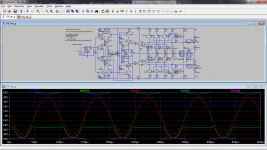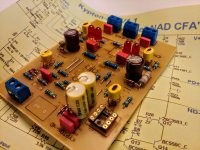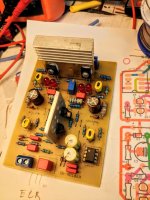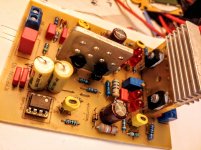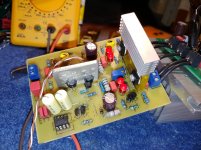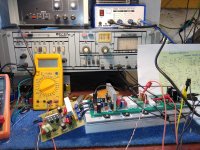"pos/neg step" has to be faster than the fastest transient the input stage can
but the transition from the lower 20v supply to the modulated
higher one is not without glitches.
Lower the glitches with faster drivers, such as 2SC4793/2SA1837? They also have lower internal capacitance too...
Sajti
OS....how about a Thread Re-Boot for POST 10,000. Do you have any ideas?
like... "It's all about the sound quality you experience in your room"
BEST SOUND WHEN: Each speaker has its own room-optimized crossover and load-optimized amplifier. So, put an active crossover for each amp channel into the amplifier chassis.
---New PCB and packaging design ideas optimzed for combining digital/analog active crossovers along with multiple amplifiers of different power and design into one chassis.
---Shared power supply and protection = common standards
---Output PCBs which can be easly converted for 1 full set or 2 partial sets of output transistors
---Diverse circuit driver PCBs which can be mounted on top of common output PCB. full or partial output set.
Beyond that = "Save the planet one amp at a time" More like - class D for
bass , class G for 100hz-20khz. SMPS to power them all.
While still retaining analog fidelity , BTW.
Edit - good idea. Bi-amping with class G +SMPS will be a new thread.
OS
Is there an accepted "amplifier efficiency vs. THD" grading system?"Save the planet one amp at a time"
More like - class D for bass , class G for 100hz-20khz. SMPS to power them all. OS
"Save the planet one amp at a time"
"Save the planet one horn speaker at a time"
For my home speakers, the woofers consume over 85% of the power.
==========
"It's all about the sound quality you experience in your room"
BEST SOUND WHEN: Each speaker has its own room-optimized crossover, and load-optimized amplifier selected for efficiency vs. THD.
Reference Candidate:
1) "Barney Oliver 26mv" Class_A/B bias point for the high power demand woofer amplifier.
2) Use Class_A Plateau Bias for the modest power demand midrange and tweeter amplifiers.
3) Share one large distributed capacitance analog power supply to reduce diode + resistance drops.
For Class_A/B amplifier circuits, there are a couple of clever, proven, efficient sliding bias schemes which could be revisited, analyzed, and updated. I've been using a Plateau Bias scheme which idles with a few watts of Class-A bias power/heat, and quickly selects a higher bias point to maintain Class_A for a modest period until a lower Class_A bias plateau can be used. None of the sonic artifacts of a fully dynamic sliding bias.
As you stated Osipper, became the receiver. Philosophy of wolferine aka boy who cried wolf. As you probably already know what is the best way to ruin a kalman filter. Recycle, bicycle, as causality.
The Precycle followed by prediction not to have a long offcycle could been probably prevented by assuming to feed right values in simulator.
So what is the moral of the story, I leave it to you
The Precycle followed by prediction not to have a long offcycle could been probably prevented by assuming to feed right values in simulator.
So what is the moral of the story, I leave it to you
Guys any recommendations which IPS i should try for slewmaster? I would try Krypton ND, but some transistors are obsolete. Also LT1022 can't find for sale..
All the transistors are still available from Mouser for the Kypton-ND. Ostripper just used the LT1022 for simulation purposes. TL072 is the normal op amp of choice for Slewmaster servos.
512-KSA1381ESTU
512-KSC3503DSTU
512-BC560CTA
512-BC550CTA
512-KSA992FTA
512-KSC1845FTA
595-TL072CP
512-KSA1381ESTU
512-KSC3503DSTU
512-BC560CTA
512-BC550CTA
512-KSA992FTA
512-KSC1845FTA
595-TL072CP
Last edited:
That is a capacitance multiplier. It is there to reduce power supply ripple going to the input board.
- Home
- Amplifiers
- Solid State
- Slewmaster - CFA vs. VFA "Rumble"
